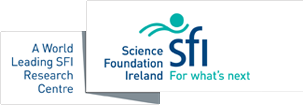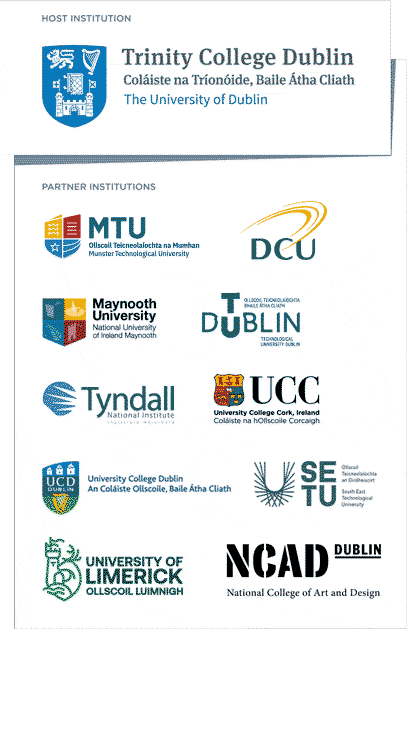CONNECT investigators at TSSG in Waterford Institute of Technology have applied their research to tackling COVID-19 .
Brendan Jennings, Sasitharan Balasubramaniam, Steven Davy and Bernard Butler, are working with colleagues to apply expertise in molecular communications to model the propagation behaviour of the virus in the respiratory system as well as using techniques for stem cell delivery. The team is also using blockchain for safe-to-work certification, and exploring the use of wearables to assist with social distancing measures.
Here are the details of their projects (courtesy of TSSG in WIT):
Treating Lung Tissue Damage due to COVID-19

(A) Illustrates MSC deposited into the alveoli of the lungs, and (B) illustrates the ultrasound signals emitted to break the polymer casing of the nanodevice.
Recent analysis of patients suffering from COVID-19 have found that stem cells can be used to repair lung damage as well as control the immune system to suppress cytokine storms (body starts to attack its own cells rather than the virus). Based on this, this specific research is looking at a new delivery mechanism of stem cells encapsulated into a polymer container into the lungs via a ventilator. Once in the right location, the nanoscale devices can be broken down using ultrasound signals emitted externally from outside the body. This will allow precise delivery of the stem cells to the damaged location within the lungs therefore aiding cell and subsequently patient recovery. The nanodevice will remain dormant in the lungs in the event a patient is re-infected.
Researchers: Bruna Fonseca (TSSG), Dr. Michael Barros (University of Tampere, Finland), Dr. Sasitharan Balasubramaniam (TSSG), Prof. David Borkholder (Rochester Institute of Technology, USA), Dr. Mark White (WIT) and Dr. Lee Coffey (TSSG, PMBRC)
Molecular Communication modelling of COVID-19 in the Respiratory System
When the COVID-19 virus enters the respiratory system, it uses the Angiotensin Converting Enzyme 2 (ACE2), found in the respiratory system, to bind and enter cells. Once COVID-19 has entered the cell the proteins within the virus will block the innate response of the immune system and replicate before being released into the body.
Depending on different factors such as the compromised immune systems and underlying health conditions, the severity of the COVID-19 infection could vary from mild to critical.
 Molecular communication model of COVID-19 virus propagation in the respiratory system.
Molecular communication model of COVID-19 virus propagation in the respiratory system.
Researchers in TSSG are studying the unpredictability of the virus within the respiratory system to identify the varying levels of infections in patients using an emerging paradigm knows as molecular communications. Molecular communication uses theory from communication engineering and networks to enables us to characterise biological communication processes. In other words, the theory will allow researchers to build a mathematical model to characterise the spread of the COVID-19 virus in the respiratory system. The model created by TSSG primarily characterises the propagation of virus particles through airway tracks and their deposition on the airway surfaces in the respiratory system. This is modelled by considering the flow of air in the upper (e.g., trachea) and lower (e.g., alveoli) regions of the respiratory system, respectively. This aim of researchers is that this model would give insights to possible treatments for COVID-19 and future life-threatening viruses by designing vaccines depending on the level of infection in different organs.
Researchers: Dixon Vimalajeewa (TSSG), Prof. Donagh Berry (Teagasc), Dr. Sasitharan Balasubramaniam (TSSG)
Safe-To-Work: Blockchain-based Certification of Compliance with Public Health Policies

Block-chain Safe-to-Work certification for people returning to work.
While the current stay-at-home policy helps to suppress the spread of the COVID-19 virus, the impact of the policy is anticipated to be both significant and long-lasting. Before the peak of the pandemic, a blanket stay-at-home solution is justifiable, but the policy needs to change when Ireland enters the maintenance phase.
To mitigate the risk of a second wave of the pandemic, the return of workers will need to be carried out gradually and controlled by the Public Health Authorities. The returning workers will be required to adhere to social distancing which is difficult to police. The compliance can be monitored via various social distancing apps coupled with the use of advanced data analytics and mathematical modelling. However, none of the apps currently available provide a mechanism for the authorities to: (1) enable safe return of workers, and (2) encourage compliance with social distancing by the returning individuals.
This project aims to develop a Blockchain Safe-to-Work certification solution to help the authorities perform both tasks. An individual may be issued a Safe-To-Work certificate confirming the safety of their temporary return. The certificate will be issued on the basis of their recent contact history and their compliance with distancing advice from Public Health Authorities. If there is evidence of recovery from the virus, a certificate may be issued by a qualified medical practitioner after certain tests have been done. The certificates will enable an organisation to make a judgment on whether the individual can return to their place of work.
Researchers: Dr. Stepan Ivanov (TSSG), Dr. Brendan Jennings (TSSG), Miguel Ponce de Leon (TSSG), Dr. Bernard Butler (TSSG), Dr. Steven Davy (TSSG).
Ensuring social distancing through wearable technology

Wearable electronic device to monitor social distancing.
Researchers are working towards an inconspicuous wearable solution to track and assess the social distancing measures by raising awareness of how people implement these guidelines within their community and work environments. TSSG is actively developing a new and innovative wearable device that can help citizens to monitor the effectiveness of their social distancing efforts and to be more informed on their practice of social distancing in real time. This wearable device solution has the potential to greatly impact and provide benefits for multiple user groups such as
- Manufacturing / industry organisations: The device will help the workforce and health and safety teamto monitor employee adoption of social distancing best practice and identify the need for additional measure to be implemented/
- Services such as hospitality and retail: The device will be capable of monitoring the behaviour of their staff and stimulate compliance amongst the customers.
- Healthcare facilities such as care homes, hospitals, GP practices:The device will support routine social distance compliance monitoring as well as helping visitors to maintain a safe distance from vulnerable individuals in such environments.
- Everyday citizen engagement (adults, kids, elderly): The device will provide these groups the opportunity to gain an insight and a higher level of awareness around their social distancing practices and areas for improvement.
Researchers: Yahya Almardeny (TSSG), Frances Cleary (TSSG), Dr. Stepan Ivanov (TSSG), Dr. Brendan Jennings (TSSG), Dr. Sasitharan Balasubramaniam (TSSG).
Details of other COVID-19 related projects at TSSG in WIT are available here.
CONNECT is the world leading Science Foundation Ireland Research Centre for Future Networks and Communications. CONNECT is funded under the Science Foundation Ireland Research Centres Programme and is co-funded under the European Regional Development Fund. We engage with over 35 companies including large multinationals, SMEs and start-ups. CONNECT brings together world-class expertise from ten Irish academic institutes to create a one-stop-shop for telecommunications research, development and innovation.


